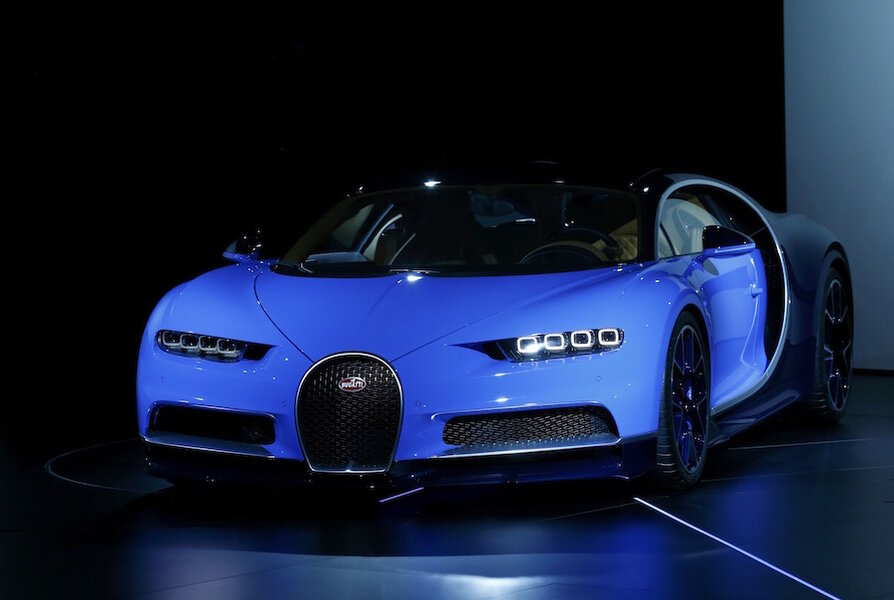Bugatti Chiron makes $2.6 million debut at Geneva Motor Show
Loading...
Behold Bugatti’s new Chiron. The much-hyped successor to the Veyron and potentially the fastest car ever to enter production has been revealed today ahead of its world debut tomorrow at the 2016 Geneva Motor Show.
We’ll cut right to the chase. Bugatti hasn’t revealed how fast the Chiron will go, at least when unrestrained. Currently, all the company will say is that the Chiron has a top speed of 261 mph but this is a governed figure for the Chiron on public roads.
Fans will be quick to note that this is slower than the current land speed record for a production car, a speed of 267.8 mph set by Bugatti’s Veyron Super Sport back in 2010. Yes, the Chiron can go faster but Bugatti remains quiet on just how much faster. A top speed of 288 mph is rumored.
What Bugatti will tell us is that the Chiron will accelerate from 0-62 mph under 2.5 seconds, which means it’s quicker off the line than the Veyron Super Sport. Accelerating to 124 mph in the Chiron will take less than 6.5 seconds and hitting 186 mph will take less than 13.6 seconds, Bugatti claims.
That’s quicker than times set by the Ferrari [NYSE:RACE] LaFerrari, McLaren P1 and Porsche 918 Spyder. Koenigsegg’s One:1 has been clocked hitting 186 mph in 11.922 seconds, though you could hardly call the One:1 a production car as just six examples plus one prototype were built.
Interestingly, the Chiron hasn’t adopted hybrid technology just yet. We say yet because it’s thought Bugatti is saving the option for a more potent Chiron down the track, something hinted at by former Volkswagen Group CEO Martin Winterkorn.
The engine is once again a quad-turbocharged 8.0-liter W-16 but now output has been dialed up to 1,500 horsepower (in metric horsepower so 1,480 hp for the United States) and 1,180 pound-feet of torque, the latter of which is available from as low as 2,000 rpm. This makes the Chiron the most powerful car in production, though this particular title is expected to pass soon to Koenigsegg’s Regera.
The extra power over the 1,184-hp Veyron Super Sport is generated via bigger turbochargers that form a sequential setup, referred to by Bugatti as “two-stage” turbocharging. Below 3,800 rpm, only two turbochargers are used. These are smaller and have very low spool-up times. Above the threshold, the two larger units come online. The result is said to be an “absolutely linear” power curve from 2,000 rpm. Additional power gains have come from a new titanium exhaust system that greatly reduces back pressure.
To handle all of the grunt, the Chiron features an all-wheel-drive system with a front-axle differential with integrated inter-axle lock and a rear-axle differential with integrated inter-wheel lock. Before reaching these, all the drive torque must go through a seven-speed dual-clutch transmission. This transmission has the largest, highest-performance clutch used on a passenger car.
All this sits within a new chassis that has a carbon fiber monocoque at its heart. The design is said to have rigidity comparable to an LMP1-spec endurance racer and features innovations such as the world’s first airbag capable of shooting through carbon fiber (used in the dashboard on the passenger side and in the seat housings), LED headlights and a driving modes selector. The outer skin of the Chiron is also made from carbon fiber.
In the cabin, the focus is on the driver and here, like the exterior, there is an air of elegance and minimalism. For example, in order to keep the central console as slim as possible and to allow a spacious impression, the climate control and infotainment systems have been separated. In front of the driver is a combination of digital and analog displays. The speedometer runs up to 500 km/h (310 mph)—something you don’t see every day.
Bugatti plans to build 500 Chirons, a total that likely includes all future variants of the car including a possible open-top version. Roughly one third of the production allocation is already accounted for, despite the car’s starting price of 2.4 million euros (approximately $2.61 million). The first examples are due to be delivered in the fall of this year.
“It is part of human nature to cross boundaries and set new records—to run 100 meters faster than ever before, to fly even further into space and to enter new realms,” Bugatti CEO Wolfgang Dürheimer said in a statement. “This striving is also our driving force at Bugatti.”
Stay tuned for all the live photos following the debut tomorrow at the Geneva Motor Show. For our complete coverage on the event, head to our dedicated hub.






